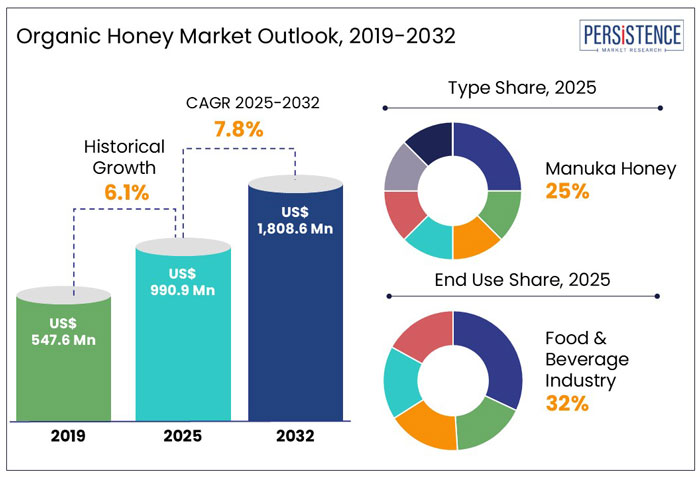Industry: Food and Beverages
Published Date: March-2025
Format: PPT*, PDF, EXCEL
Delivery Timelines: Contact Sales
Number of Pages: 320
Report ID: PMRREP32773
The global organic honey market is expected to grow from US$ 990.9 Mn in 2025 to US$ 1,808.6 Mn in 2032, at a substantial CAGR of 7.8% from 2025 to 2032.

|
Attribute |
Key Insights |
|
Market Size (2025E) |
US$ 990.9 Mn |
|
Projected Sales of Organic Honey (2032F) |
US$ 1,808.6 Mn |
|
Value CAGR (2025-2032) |
7.8% |
|
Value Share of Top 5 Countries (2024A) |
48% |
According to Persistence Market Research, the organic honey market is witnessing significant growth due to rising consumer preference for natural and chemical-free sweeteners, driven by increasing awareness of health benefits and sustainable sourcing. Unlike conventional honey, organic honey is produced without synthetic pesticides, antibiotics, or genetically modified organisms (GMOs), making it a sought-after product in health-conscious and environmentally aware demographics. The demand surge is particularly strong in North America and Europe, where stringent regulations and certification requirements, such as USDA Organic and EU Organic, shape market dynamics. Moreover, the growing use of organic honey in functional foods, nutraceuticals, and skin care products is expanding its market scope beyond traditional consumption.
The organic honey market has witnessed steady growth over the past decade, driven by rising consumer preference for natural and chemical-free sweeteners. Historically, from 2019 to 2024, the market experienced a compound annual growth rate (CAGR) of approximately 5%-7%, fueled by increased awareness regarding the health benefits of organic honey, such as its antioxidant, antimicrobial, and anti-inflammatory properties. Additionally, the rise of small-scale beekeeping enterprises and fair-trade initiatives strengthened the supply chain, supporting market expansion.
Looking ahead, the organic honey market is poised for a robust trajectory. It is projected to grow at a CAGR of 7.4% from 2025 to 2032. Several factors will drive this growth, including the increasing adoption of organic diets, a shift toward sustainable and ethical food sourcing, and growing demand from the nutraceutical and functional food industries.
“Rising Demand for Natural Sweeteners Benefiting Organic Honey Suppliers”
Demand for natural sweeteners is significantly increasing as young consumers prefer them over artificial sweeteners because of increasing health concerns. Natural sweeteners are safe and secure for consumption and also provide nutritional benefits to the body. This is the reason why consumers are looking for natural organic sweeteners as a replacement to white sugar for tea, coffee, yogurt, baked food, and many other applications.
Natural sweeteners contain proteins, polyphenols, amino acids, and terpenoids, which offer safety, security, delicious taste, and high-quality nutrients to the finished products that health-conscious consumers widely use.
“Growing Use of Organic Honey in Alcoholic Beverages”
Honey wine is brewed from organic honey, yeast, and water. The product is very popular in many regions of the world. Demand for this beverage is increasing due to its recognition as one of the oldest alcoholic beverages enjoyed by ancient Greeks, Romans, and Africans. This gives an extra Unique Selling Point (USP) to the product in the market.
High production of alcoholic beverages is driving demand for organic honey. Consumption of alcoholic drinks is increasing among adults, and honey wine is the best healthy alternative to regular alcoholic drinks. Honey wine possesses several benefits such as containing various minerals, vitamins, and enzymes, which makes it a healthy choice for consumers.
The supply of organic honey has witnessed significant year-on-year growth as consumers adopt a healthy lifestyle. Organic honey is ethically produced, pure, safe, secure, high in quality, and delivers healthy nutrients. It has antimicrobial, antibacterial, and anti-inflammatory properties that help cure various diseases.
This increases demand for organic honey in food and non-food applications around the world. India and China are emerging markets for organic honey products, as customer preferences are shifting toward organic honey due to growing awareness of the ill effects of artificial sweeteners. hence, these countries offer lucrative opportunities for organic honey manufacturers in the Asia Pacific region.
“Wide Availability of Organic Honey Substitutes”
Sugar and artificial sweeteners are substitutes for organic honey. Artificial sweeteners are obtained from natural substances such as herbs or sugar. Artificial sweeteners contain much more sugar than refined sugar, which is widely used in jams and jellies, baked food, dairy products, soft drinks, and more. Besides, the cost of producing organic honey is also higher than regular honey and its substitutes.
Artificial substitutes such as aspartame and acesulfame are used to sweeten soft drinks, saccharin and sucralose are used to sweeten food and drinks, and stevia is obtained from a herb that is used for sweetening food and drinks. These substitutes for organic honey are easily available in the market and come at a more affordable price. Thus, strong presence of substitutes in the market will hamper growth of the organic honey market to some extent.
“Declining Bee Populations and Colony Collapse Disorder (CCD)”
The alarming decline in global bee populations, driven by habitat destruction, pesticide exposure, and climate change, significantly restricts organic honey production. Colony Collapse Disorder (CCD), a phenomenon where entire colonies disappear, has emerged as a major threat, leading to reduced honeybee populations and lower honey yields. Unlike conventional beekeeping, organic honey production prohibits synthetic chemicals and artificial hive interventions, making colonies more vulnerable to environmental stressors.
One key issue is pesticide drift from non-organic farms, which can expose organic hives to harmful neonicotinoids, impairing bee immunity and foraging efficiency. Additionally, erratic weather patterns caused by climate change, such as prolonged droughts and unseasonal rains, disrupt floral nectar cycles, limiting bees’ access to organic nectar sources. These challenges reduce honey output and create supply inconsistencies, driving up costs for organic honey producers.
Furthermore, the loss of wildflower-rich habitats has diminished forage diversity, weakening bee nutrition and colony resilience. As a result, beekeepers must invest more in hive management, sustainable foraging zones, and alternative pollination support systems, increasing production costs. This ongoing crisis threatens long-term sustainability, forcing the industry to adopt innovative solutions such as AI-driven hive monitoring and regenerative agriculture to mitigate the decline of honeybee populations.
Organic honey production is significantly costlier than conventional honey due to strict certification requirements and sustainable beekeeping practices. Beekeepers must ensure that hives are placed within a 3-5 mile radius of pesticide-free foraging zones, which limits hive placement options and often necessitates leasing organic farmland. Additionally, organic certification mandates the use of natural hive treatments to combat pests like Varroa mites, prohibiting synthetic chemicals commonly used in conventional beekeeping. Instead, beekeepers rely on costly organic alternatives like essential oil treatments or controlled heat applications, further increasing production expenses.
The certification process itself is also expensive, requiring annual inspections, lab testing, and extensive documentation to verify compliance. In the European Union and the United States, organic honey producers must adhere to multiple regulatory frameworks, including EU Organic Standards and the USDA National Organic Program (NOP), each with its own costly compliance measures.
“Diverse Flora and Rich Nectar Sources Fuel China’s Honey Production”
China dominates the organic honey market due to its vast beekeeping industry, diverse floral resources, and government support for organic agriculture. As the world's largest honey producer, China benefits from large-scale apiculture, particularly in provinces like Sichuan, Yunnan, and Guangxi, where diverse wildflowers provide rich nectar sources. The country has also invested heavily in organic certification programs, ensuring compliance with international standards for pesticide-free honey production.
In the Asia-Pacific region, China stands out due to its high adoption of traditional and modern beekeeping techniques. The widespread use of Apis cerana and Apis mellifera species enhances honey yield, while technological advancements in hive management improve productivity. Additionally, the growing demand for organic food among Chinese consumers, coupled with rising exports to Europe and North America, fuels the sector’s expansion. The government’s push for sustainable farming and ecological conservation further boosts organic honey output, positioning China as the regional leader.
Despite challenges like counterfeit honey concerns and climate fluctuations, China maintains its dominance through research-driven improvements in beekeeping practices, strong supply chain networks, and competitive pricing. These factors ensure China's continued leadership in both the global and Asia-Pacific organic honey markets.
“Strong Consumer Demand Fuels Organic Honey Growth in Europe”
Europe holds a significant share in the organic honey market after Asia-Pacific due to stringent organic certification standards, strong consumer demand for natural products, and government policies promoting sustainable agriculture. Countries like Germany, France, and Italy have well-established organic farming regulations that ensure high-quality honey production without synthetic pesticides or antibiotics. These standards enhance consumer trust and drive demand for premium organic honey.
Additionally, the European market benefits from a strong preference for organic and sustainable food choices. Health-conscious consumers increasingly seek chemical-free, ethically sourced honey, boosting local production and imports from certified organic suppliers worldwide. The European Union (EU) supports organic farming through subsidies and regulatory frameworks, encouraging beekeepers to adopt eco-friendly practices.
Manuka honey leads the global organic honey market due to its exceptional antibacterial properties, premium positioning, and strong demand in the health and wellness sector. Sourced primarily from New Zealand and Australia, Manuka honey contains high levels of methylglyoxal (MGO), a compound known for its powerful antimicrobial activity. This makes it a preferred choice for medicinal and therapeutic applications, including wound healing, immune support, and digestive health. Unlike conventional honey, Manuka honey undergoes rigorous grading based on its Unique Manuka Factor (UMF), ensuring quality and authenticity, further boosting consumer trust.
The Food & Beverage Industry is the fastest-growing end-use segment in the global organic honey market due to shifting consumer preferences toward natural, health-enhancing ingredients and clean-label food products. With increasing awareness of the harmful effects of artificial sweeteners and refined sugar, consumers are actively seeking healthier alternatives, and organic honey has emerged as a preferred natural sweetener. This trend is particularly strong in developed markets like North America and Europe, where demand for functional foods, organic products, and clean-label ingredients is at an all-time high.
Moreover, the rising popularity of plant-based and organic diets has further propelled the use of organic honey in various food applications, including bakery products, confectionery, cereals, beverages, dairy, and nutritional bars.

Manufacturers of organic honey are offering it for various applications to meet the rising demand of different target industries. They are also focusing on increasing their production capacity and investing in research and development.
The latest technological integration in processing, detection, quality-enhancing, etc., will help organic honey producers provide their products at competitive prices. This is expected to benefit them in producing organic honey more sustainably.
|
Attribute |
Details |
|
Forecast period |
2025-2032 |
|
Historical data available for |
2019-2024 |
|
Market analysis |
USD million for value, Volume (Tons) |
|
Key regions covered |
|
|
Key market segments covered |
|
|
Key companies profiled |
|
|
Report Coverage |
|
|
Customization & pricing |
Available upon request |
By Type:
By End Use:
By Distribution Channel:
By Region:
To know more about delivery timeline for this report Contact Sales

The global market is expected to grow from US$ 990.9 Mn in 2025 to US$ 1,808.6 Mn in 2032.
Rising health awareness and demand for natural, chemical-free sweeteners are boosting organic honey sales globally.
According to Persistence Market Research’s projections, Europe currently dominates the global organic honey market.
Major end-use industries for organic honey include food & beverages, cosmetics & personal care, pharmaceuticals, and retail/household.
Top market players include Manuka Health New Zealand Limited, Lamex Food Group Ltd., Wedderspoon Organic Inc., and Heavenly Organics, LLC, with an estimated market share of 20% to 30%.
High production of organic honey is majorly observed in China, India, Brazil, the U.S., New Zealand, and Argentina.